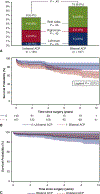Unilateral is comparable to bilateral antegrade cerebral perfusion in acute type A aortic dissection repair
- PMID: 31587891
- PMCID: PMC7061338
- DOI: 10.1016/j.jtcvs.2019.07.108
Unilateral is comparable to bilateral antegrade cerebral perfusion in acute type A aortic dissection repair
Abstract
Objective: To compare the short- and long-term outcomes of unilateral and bilateral antegrade cerebral perfusion (uni-ACP and bi-ACP) in acute type A aortic dissection (ATAAD) repair.
Methods: From 2001 to 2017, 307 patients underwent surgical repair of an ATAAD using uni-ACP (n = 140) and bi-ACP (n = 167). Data were collected through the Department of Cardiac Surgery Data Warehouse, medical record review, and the National Death Index database.
Results: The demographics and preoperative comorbidities were similar between the uni-ACP and bi-ACP groups. Both groups had similar rates of procedures for aortic valve/root, ascending aorta, frozen elephant trunk, and other concomitant procedures. Perioperative outcomes were not significantly different between the 2 groups (30-day mortality: uni-ACP 3.4% vs bi-ACP 7.8%, P = .12) except reoperation for bleeding was significantly lower in uni-ACP (5% vs 12%, P = .03). Between the uni-ACP and bi-ACP groups, overall postoperative stroke rate (6% vs 9%, P = .4) and left brain stroke rate (0.7% vs 3.0%, P = .23) were not significantly different. The odds ratio of uni-ACP versus bi-ACP was 0.87 (P = .80) for postoperative stroke and 0.86 (P = .81) for operative mortality. The mid-term survival was better in the uni-ACP group, P = .027 (5-year: 84% vs 76%). The hazard ratio of all-time mortality for uni-ACP versus bi-ACP was 0.74 (95% confidence interval, 0.33-1.65), P = .46.
Conclusions: In ATAAD, both uni-ACP and bi-ACP are equally effective to protect the brain with low postoperative stroke rates and mortality in hemiarch to zone 3 arch replacement. Uni-ACP is recommended for its simplicity and less manipulation of arch branch vessels.
Keywords: antegrade cerebral perfusion; aortic arch replacement; aortic dissection; stroke; survival.
Copyright © 2019 The American Association for Thoracic Surgery. Published by Elsevier Inc. All rights reserved.
Conflict of interest statement
Figures


Comment in
-
Commentary: Have we finally settled the debate of unilateral versus bilateral antegrade cerebral perfusion for brain protection during type A repair?J Thorac Cardiovasc Surg. 2020 Sep;160(3):626-627. doi: 10.1016/j.jtcvs.2019.07.118. Epub 2019 Sep 5. J Thorac Cardiovasc Surg. 2020. PMID: 31562016 No abstract available.
-
Commentary: Can unilateral antegrade cerebral perfusion constitute a unified method for acute type A aortic dissection repair?J Thorac Cardiovasc Surg. 2020 Sep;160(3):627-628. doi: 10.1016/j.jtcvs.2019.07.114. Epub 2019 Sep 5. J Thorac Cardiovasc Surg. 2020. PMID: 31562017 No abstract available.
Comment on
-
Bilateral versus unilateral antegrade cerebral perfusion in total arch replacement for type A aortic dissection.J Thorac Cardiovasc Surg. 2017 Sep;154(3):767-775. doi: 10.1016/j.jtcvs.2017.02.053. Epub 2017 Mar 12. J Thorac Cardiovasc Surg. 2017. PMID: 28420537
References
-
- Trimarchi S, Nienaber CA, Rampoldi V, Myrmel T, Suzuki T, Mehta RH, et al. Contemporary results of surgery in acute type A aortic dissection: The International Registry of Acute Aortic Dissection experience. J Thorac Cardiovasc Surg. 2005;129:112–122. - PubMed
-
- Lee TC, Kon Z, Cheema FH, Grau-Sepulveda MV, Englum B, Kim S, et al. Contemporary management and outcomes of acute type A aortic dissection: An analysis of the STS adult cardiac surgery database. J Card Surg. 2018. - PubMed
-
- Parikh N, Trimarchi S, Gleason TG, Kamman AV, di Eusanio M, Myrmel T, et al. Changes in operative strategy for patients enrolled in the International Registry of Acute Aortic Dissection interventional cohort program. J Thorac Cardiovasc Surg. 2017;153:S74–S79. - PubMed
-
- Tong G, Zhang B, Zhou X, Tao Y, Yan T, Wang X, et al. Bilateral versus unilateral antegrade cerebral perfusion in total arch replacement for type A aortic dissection. J Thorac Cardiovasc Surg. 2017;154:767–775. - PubMed
Publication types
MeSH terms
Grants and funding
LinkOut - more resources
Full Text Sources
Other Literature Sources
Medical

